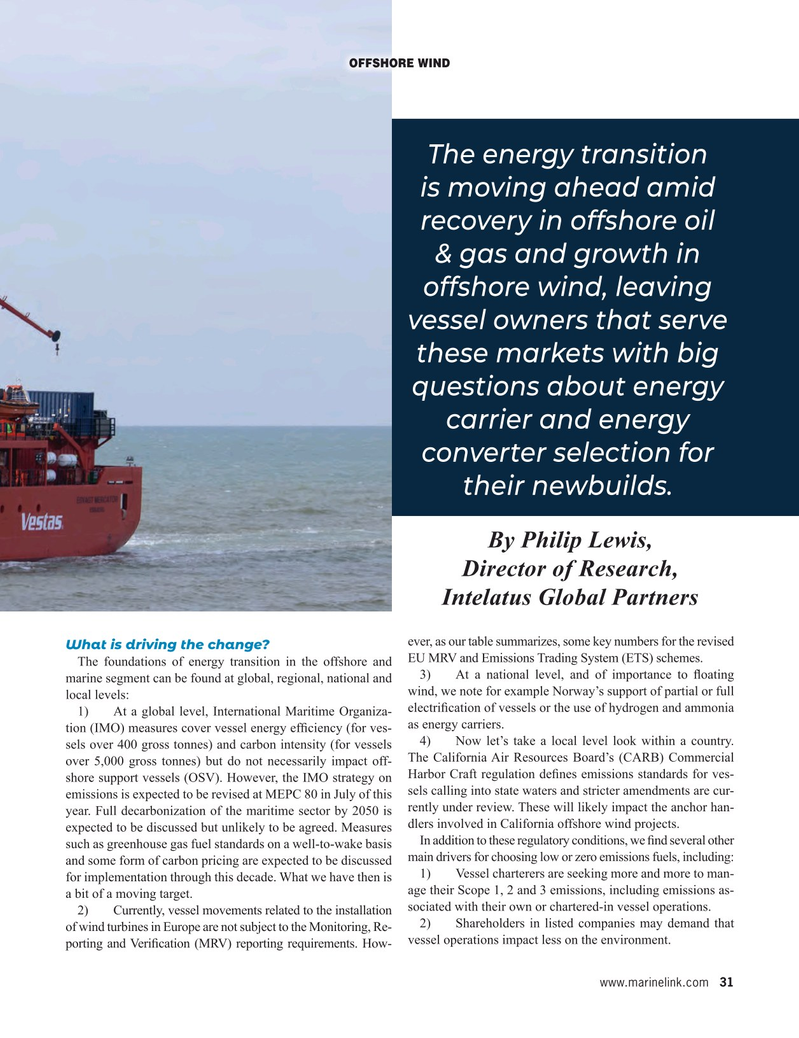
Page 31: of Maritime Reporter Magazine (June 2023)
The Digital Ship
Read this page in Pdf, Flash or Html5 edition of June 2023 Maritime Reporter Magazine
OFFSHORE WIND
The energy transition is moving ahead amid recovery in offshore oil & gas and growth in offshore wind, leaving vessel owners that serve these markets with big questions about energy carrier and energy converter selection for their newbuilds.
By Philip Lewis,
Director of Research,
Intelatus Global Partners ever, as our table summarizes, some key numbers for the revised
What is driving the change?
The foundations of energy transition in the offshore and EU MRV and Emissions Trading System (ETS) schemes. 3) At a national level, and of importance to ? oating marine segment can be found at global, regional, national and wind, we note for example Norway’s support of partial or full local levels: electri? cation of vessels or the use of hydrogen and ammonia 1) At a global level, International Maritime Organiza- as energy carriers.
tion (IMO) measures cover vessel energy ef? ciency (for ves- 4) Now let’s take a local level look within a country. sels over 400 gross tonnes) and carbon intensity (for vessels
The California Air Resources Board’s (CARB) Commercial over 5,000 gross tonnes) but do not necessarily impact off- shore support vessels (OSV). However, the IMO strategy on Harbor Craft regulation de? nes emissions standards for ves- sels calling into state waters and stricter amendments are cur- emissions is expected to be revised at MEPC 80 in July of this year. Full decarbonization of the maritime sector by 2050 is rently under review. These will likely impact the anchor han- expected to be discussed but unlikely to be agreed. Measures dlers involved in California offshore wind projects.
In addition to these regulatory conditions, we ? nd several other such as greenhouse gas fuel standards on a well-to-wake basis and some form of carbon pricing are expected to be discussed main drivers for choosing low or zero emissions fuels, including: 1) Vessel charterers are seeking more and more to man- for implementation through this decade. What we have then is age their Scope 1, 2 and 3 emissions, including emissions as- a bit of a moving target.
2) Currently, vessel movements related to the installation sociated with their own or chartered-in vessel operations. 2) Shareholders in listed companies may demand that of wind turbines in Europe are not subject to the Monitoring, Re- vessel operations impact less on the environment.
porting and Veri? cation (MRV) reporting requirements. How- www.marinelink.com 31
MR #6 (18-33).indd 31 6/5/2023 9:25:35 AM

 30
30

 32
32
